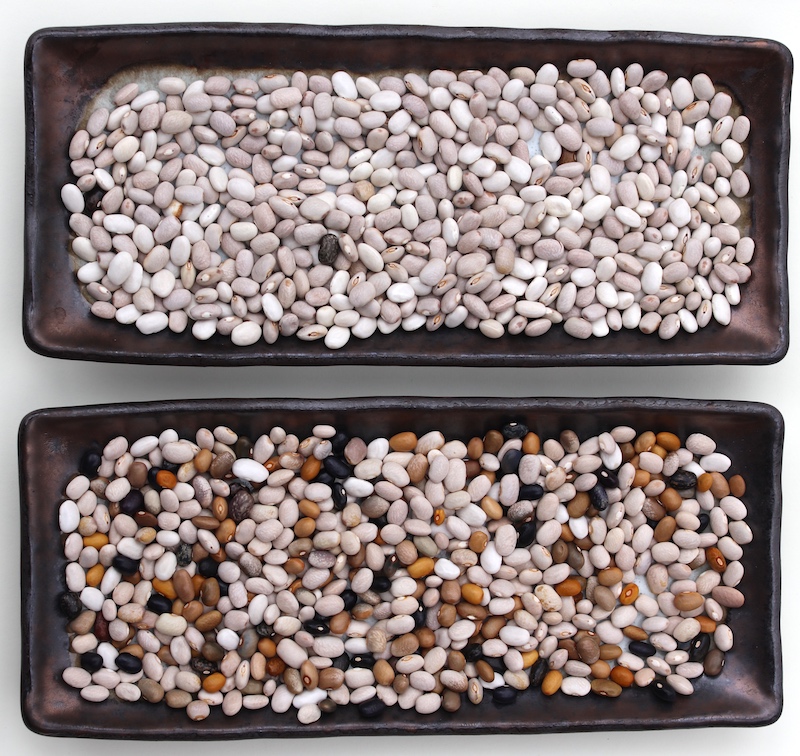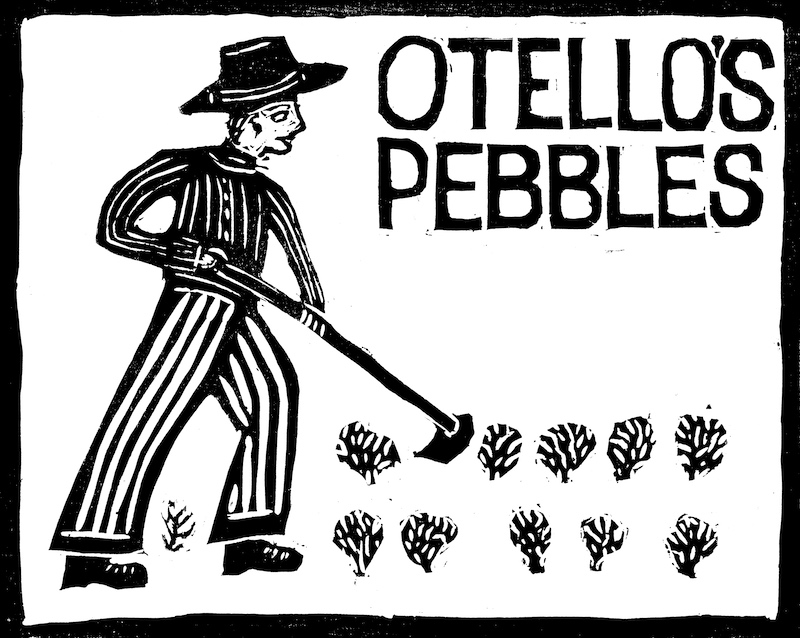
Farm Bulletin: Otello's Pebbles, Stewarding a Bean's Genetics
Contributor Anthony Boutard writes: "Here is a note I prepared regarding Otello’s [Pebbles, one of the dried beans Anthony grows at Ayers Creek Farm]. On my restaurant availability list, I usually include a 'photo of the moment' followed by a note placing it in context. One week I didn’t have time to comb my photo files and draft a note, so I simply stated that due to a lack of a sponsor, there was no photo. That led to a series of fictitious sponsors."
Photo of the Moment
Generously Sponsored by: Bard, Rossini & Verdi Concepts™
Cantiamo, Salce
In 2015, we were sent an irritatingly small package of beans by Nancy Jenkins, a food writer and olive oil maker. People often leave kittens and cats at farms assuming they will be cared for in some unspecified way; mostly and fittingly, the caregivers are the farm’s coyotes or bald eagles always looking for a meal more exotic than the usual fare of mice and voles.

Likewise, small packages of pretty beans are sent or given to us in the hopes that we will become their genetic stewards. Sometimes, an endearing note explains that the beans are a family heirloom and were found in a late aunt’s garage where they had been stored for five years in a mason jar. As a further tug on the heartstrings, and doubling down on their pedigree, a charming name is given to them. A name in a tongue from the old country amps up the hype. Somehow, sending them to us assuages the custodian’s guilt of not carrying on the family tradition themselves. Despite claims made by various wags about sacred beans found in some ancient granary, garden beans are viable for about two years, after that their vitality drops off the cliff. Such claims are just as likely as the old temple cat that is still haunting the pyramid some 5,000 years later.
The package in question had a note, written by another person in the chain of stewardship. It noted that the bean was grown by someone called Otello who died early and had praised the bean as growing well in poor soil. Not much of an endorsement, and not a word about its culinary qualities. Worse, the package contained what appeared to be an assortment of types, something bean growers work hard to avoid. The custodian’s tag noted they were named "Fagioli bianci • grigi," again no first-hand endorsement of their culinary merit.
The package would have been relegated to the ACF seed museum (i.e. compost) except that Myrtha Zierock [an intern at the farm that year] and I were planting a block of soy and had space for a few more seeds. Some beans are promiscuous and will contaminate a field of a carefully managed commercial crop. Soy and garden beans do not cross pollinate so there was not harm in filling out the row. We joked that the beans looked like little pebbles and tossed them into the seeder. At harvest, we cooked up the beans and found they had their redeeming qualities. Because of their appearance, we named them Otello’s Pebbles.
In preparing for the 2020 harvest, we went out to select the 2021 seed crop and discovered the beans had drifted away from the original beguiling mix that prompted our impulsive sowing, and were now almost entirely white or light gray. The translation of Otello’s name for them was "beans white • grey", so they were probably closer to his beans than the “pebbles” passed on from their custodian—those we received in the mail. We combed the field looking for every plant that produced something other than white and light grey. In the lower dish (top photo), you can see the restored variation which is close to those in the seed package Jenkins sent to us.
Does it matter? I think so. We grow many carefully managed beans, but for a bean suited to the stew pot, a bit of a topsy-turvy mix of flavors and textures make for a far more interesting ingredient. I assumed that the genetically chaotic mix would take care of itself, but I was wrong. We have to be just as diligent in our pebbled seed selection as we are with zolfino, for example. It is a bit more of a challenge because we need to make sure we have a full and balanced selection of the original colors, as opposed to selecting for just one color.
We have tried the new selection on the plate and last September’s work was worth the effort. The restructured variety is head-and-shoulders better flavored than the "white • grey" mix corresponding to Otello’s original bean. Frankly, it is no wonder Otello failed to rhapsodize over their quality. Indeed, it is now up there with the all of our other beans, even better than that first harvest that caught our attention. If you think Italian makes the bean sound sexier, then call it sassolini di Otello delivered in the style of Keven Kline, all the same to me. But be sure to try them. You won’t regret heeding the farmer’s suggestion.
Note: The sponsor’s motto is based on Act 4, Scene 3 of Othello when Desdemona sings the Willow Song in her distress and betrayal. The words are condensed from Verdi’s version “Salce, salce, salce, cantiamo, cantiamo, cantiamo, salce, salce, salce (willow, let us sing). I am partial to Rossini’s version, though. Here is a beautiful version in recital by Joyce DiDonato accompanied by David Zobel.
Top photo: Otello’s Pebbles, 2020 (upper) and 2021 (lower) by Anthony Boutard.
* In an exchange about the label (above), Anthony clarified that, alas, the farmer is not Otello: "Otello was long dead when I received the beans. The Otello's block is influenced by the simple, bold renderings of the early 20th Century Mexican woodblock prints, particularly those of María Izquierdo and David Alfaro Sigueiros."